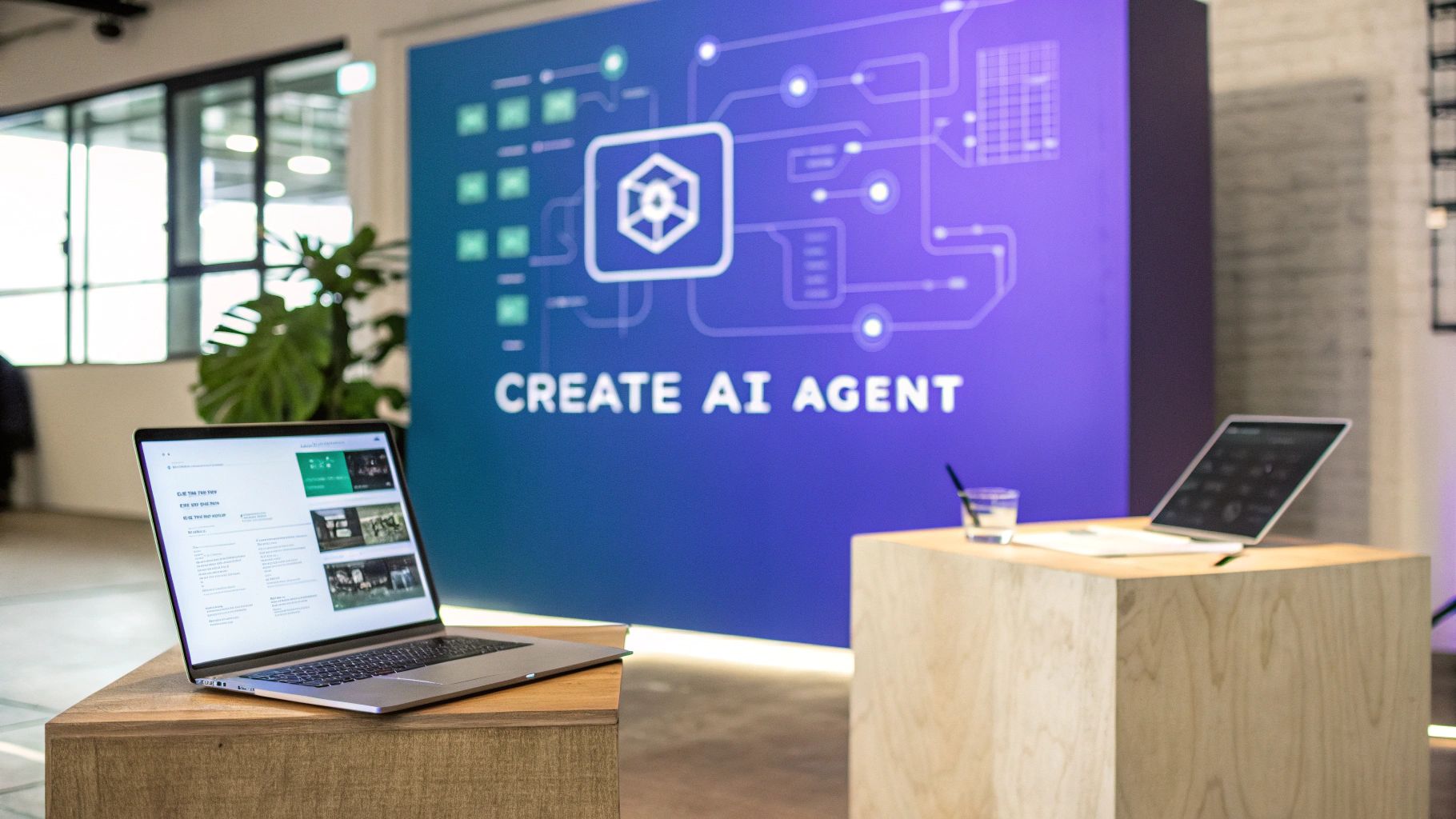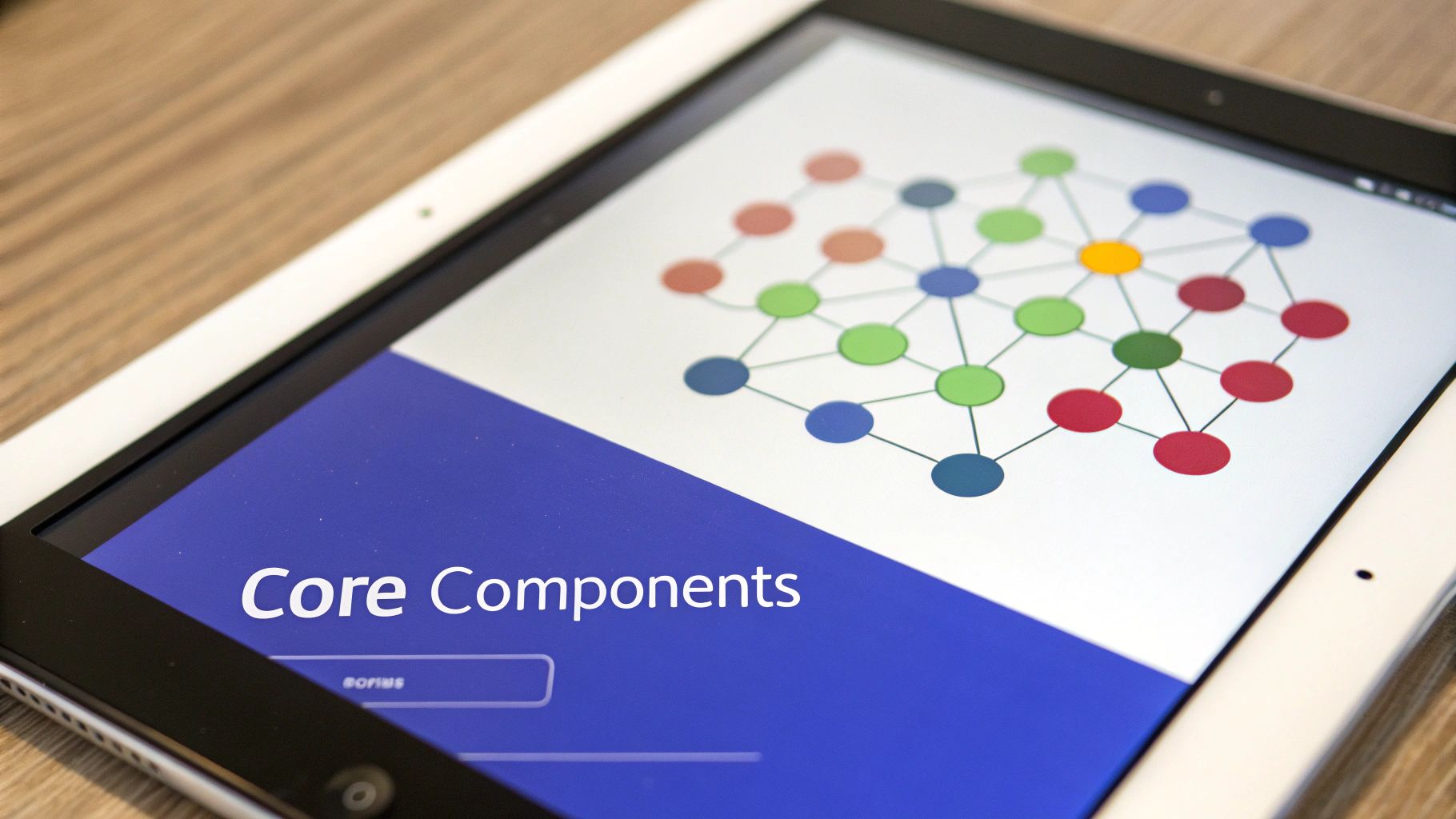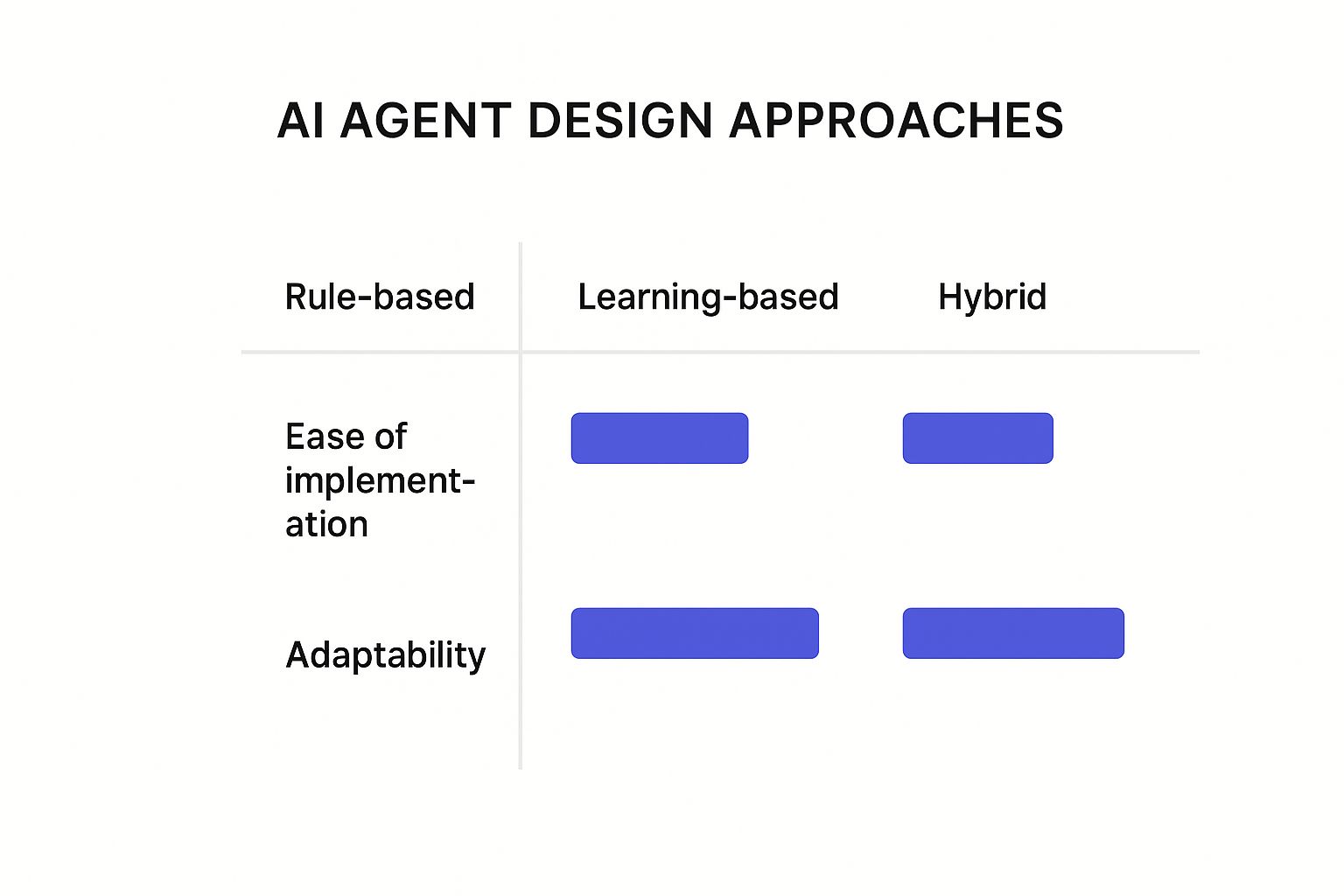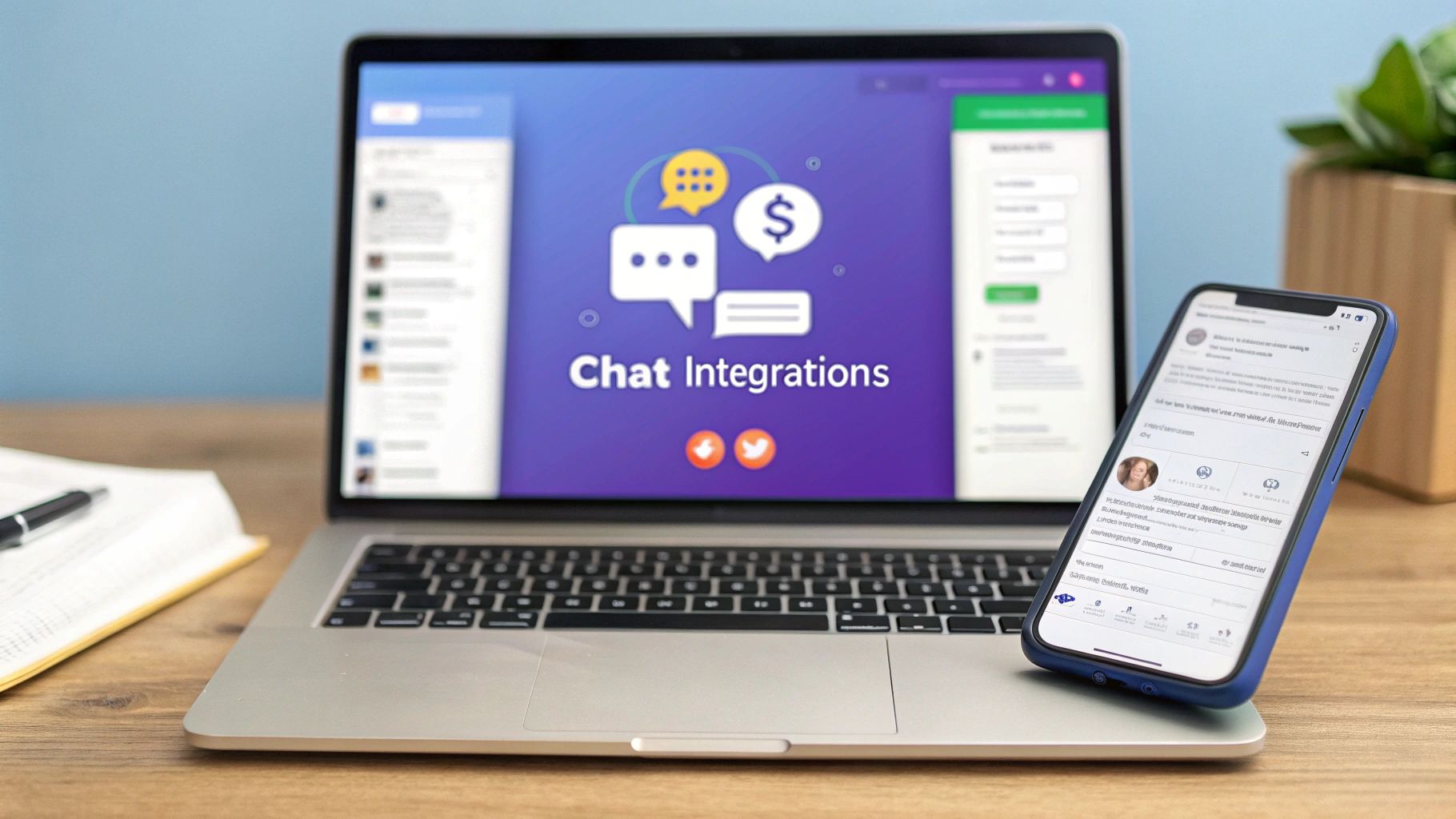How to Create an AI Agent Your Practical Guide
Learn how to create an AI agent with our practical guide. We cover everything from planning and development to training and deployment for real-world results.

Ever feel like the conversation around AI agents is all theory and no action? For a long time, it was. But that's changed.
We've moved past the "what if" stage. Businesses are now actively building and deploying these tools to handle complex workflows, freeing up their teams for more important work. Unlike a simple chatbot that just follows a script, a true AI agent can think for itself—it can reason, plan, and execute tasks to hit a specific goal.
This guide is all about getting your hands dirty. We'll walk through the entire process, from that first spark of an idea to a fully functioning agent that adds real value to your business.

Why Build an AI Agent Now?
The momentum is impossible to ignore. AI agent tech is being adopted everywhere, from software development teams to large-scale enterprise operations. This isn't just a trend for the tech giants anymore; accessible platforms have put powerful automation within reach for businesses of all sizes.
The numbers don't lie. Microsoft recently reported that over 230,000 organizations, including a staggering 90% of Fortune 500 companies, are already using tools like Copilot Studio to build custom AI assistants. You can dive into more data on AI agent adoption to see just how fast this is growing. This isn't a fad; it's a fundamental shift in how work gets done.
The real magic of an AI agent is its ability to move from just following instructions to actively solving problems. It doesn't just answer a question—it takes the initiative to find a solution.
Core Stages of AI Agent Creation
So, where do you start? Building an AI agent isn't a single action but a series of deliberate stages. Each step builds on the last, guiding your idea from a rough concept to a polished, effective tool. Think of it as a roadmap for turning your vision into reality.
Here’s a breakdown of what that journey looks like.
Grasping these four core stages is the first step. It gives you a clear framework to ensure your final agent is not only functional but also perfectly aligned with what you set out to achieve.
Setting Your AI Agent Up for Success

It’s tempting to jump straight into building an AI agent. The tools are there, and the possibilities feel endless. But diving in without a clear plan is like setting sail without a map—you’ll definitely end up somewhere, but probably not where you intended.
This initial planning phase is easily the most important step. Get this right, and you're on the path to creating an AI agent that delivers real, measurable value.
The very first thing you need to do is define a single, precise goal. It's easy to get carried away and try to build an agent that "does everything," but that’s a recipe for failure. Instead, narrow your focus to a specific, high-impact problem you want to solve.
For example, a common headache for operations teams is the sheer volume of customer support tickets. The goal here isn't just to "handle support." A much better, more actionable goal is to "autonomously categorize and assign all incoming support tickets to the correct department within two minutes." That kind of clarity is what separates a successful project from a frustrating one.
Define the Scope and Key Tasks
Once you have that crystal-clear goal, you can start mapping out the agent's specific responsibilities. What exact actions must it perform to hit that target? For our support ticket agent, the task list might look something like this:
- Read Incoming Tickets: The agent needs to constantly monitor the support inbox or helpdesk platform.
- Analyze Ticket Content: It has to understand what the user is actually saying to figure out the issue (e.g., is this a billing question, a technical bug, or a feature request?).
- Categorize the Issue: Based on its analysis, it assigns a specific category.
- Route the Ticket: The agent then pushes the ticket to the right team's queue, like Finance or Tier 2 Support.
- Send a Confirmation: Finally, it pings the customer to let them know their ticket has been received and routed.
This task list creates the agent's operational sandbox. Anything not on this list is officially out of scope, which is your best defense against feature creep and keeps the project from spiraling out of control. This focused approach is just as crucial when building a specialized tool like an AI chatbot for Google Chat, where a tightly defined purpose almost always leads to better, more reliable performance.
Establish Your Metrics for Success
So, how will you know if your agent is actually doing a good job? You need to decide on your Key Performance Indicators (KPIs) before you write a single line of code. These metrics are what turn a vague goal into a measurable outcome.
An AI agent without clear KPIs is just a science experiment. An agent with well-defined metrics is a business tool designed for measurable improvement and a clear return on investment.
Sticking with our support agent example, your KPIs could include:
- Ticket Misrouting Rate: What percentage of tickets are sent to the wrong department? The goal should be to keep this below 5%.
- Average Time to Assign: How long does it take from the moment a ticket is created until it's in the right team's hands? Let's aim for under 2 minutes.
- Agent Intervention Rate: How often does a human have to step in and correct the agent's work?
These KPIs give you a concrete benchmark for success. They guide the entire development process and provide a clear framework for testing and fine-tuning later. Without them, you’re just flying blind, unable to prove the agent's value or even know where to make improvements. This foundational work is what truly sets your AI agent up for success from day one.
Choosing Your AI Agent Development Path
Once you’ve nailed down why you need an AI agent, the next big question is how you’re going to build it. This is a critical fork in the road. The path you choose will shape your project's speed, cost, and complexity, so it's a decision that deserves some real thought.
Ultimately, the right choice boils down to your team's resources and what you need your agent to accomplish. You’ve got two main routes you can take: build it from scratch with a coding framework or use a no-code platform to get it done faster.
The Two Core Approaches
The market for agent development is split pretty cleanly into two camps. On one side, you have agent frameworks—the building blocks developers love for their raw power and control. On the other, you have agent providers that offer ready-to-use AI agents with a focus on simplicity and speed.
This split really highlights the classic trade-off between flexibility and time-to-market. Let's break down what each path looks like in practice.
Agent Frameworks (e.g., LangChain, AutoGen): This is the custom-build route. Think of these as toolkits packed with the raw components needed to construct highly specialized agents. You get total control over every little detail, from the underlying language models to the agent's intricate reasoning loops. It offers maximum flexibility but demands serious coding skills and a much longer development timeline.
Agent Providers (e.g., Chatiant): This is the no-code or low-code path. Platforms like ours give you a visual interface to assemble, train, and launch an agent without touching a single line of code. It’s a perfect fit for teams that don't have dedicated AI developers or for projects where getting to market quickly is the number one priority. You trade some of the deep, granular control of a framework for a dramatically faster and more accessible process. If that sounds like your situation, you can learn more about getting started with a no-code AI agent builder.
The image below shows how these different approaches to agent design balance implementation ease with their ability to adapt and learn.

As you can see, while more sophisticated learning-based agents offer incredible adaptability, simpler rule-based systems are much easier to get up and running. This is a core trade-off to keep in mind.
Agent Providers vs Agent Frameworks
To make the decision clearer, here's a direct comparison to help you choose the right approach for building your AI agent based on key project requirements.
Choosing the right path isn't about which one is universally "better," but which one is better for you.
Making the Right Decision
So, how do you decide? It isn't about finding the "best" option, but the one that best fits your specific situation.
For instance, a startup that needs an AI sales assistant to book meetings yesterday would get immense value from the speed of a provider like Chatiant. On the other hand, a large financial institution building a proprietary fraud detection system might need the deep, granular customization that only a framework can provide.
It all comes down to one question: Is your primary limitation technical expertise or time?
If you don't have a team of developers ready to go, a provider is your best bet. If you have the engineering talent and a non-negotiable need for unique, custom-built functionality, then a framework is the logical choice.
Building and Training Your First AI Agent

Alright, you've got your goals mapped out and a development path chosen. Now for the fun part: rolling up your sleeves and actually building something. This is where the abstract idea of an "AI agent" becomes a real, working tool for your team.
We'll focus on the no-code route using a platform like Chatiant. It's the fastest way to get from concept to reality, and you don’t need a background in programming to make it happen.
Your first move is to give the agent its core identity. This is more than just a name; you’re setting its fundamental purpose and personality with a set of initial instructions. Think of it as the agent's prime directive—a core principle that will shape every single one of its future actions.
For instance, if you're building an agent for sales qualification, its core instruction could be: "You are a friendly and efficient sales assistant. Your main goal is to qualify new leads by asking about their company size, primary needs, and budget. Always be polite, professional, and never promise features that don't exist."
Just like that, you've set the tone and operational boundaries from the get-go.
Connecting Your Agent to Knowledge
An agent is only as good as the information it can pull from. This is where you connect it to its "brain"—the knowledge sources it will lean on to answer questions and make decisions. This is one of the most important steps in learning how to create an AI agent that's truly helpful.
Modern platforms make this surprisingly simple. You can connect knowledge sources with just a few clicks:
- Website Crawling: Just plug in your website's URL, and the platform will automatically scan and index the content. This is perfect for agents that need to field questions based on your public-facing info.
- Document Uploads: Got internal knowledge bases, product manuals, or detailed policy documents? You can directly upload PDFs, Word docs, or text files.
- Direct Text Input: For very specific or nuanced information, you can simply paste text directly into the agent’s knowledge base.
By layering these sources, you create a rich, custom repository of information for your agent. For a deeper look at this process, check out our complete guide on how to build AI agents with Chatiant.
The real power comes from combining multiple sources. An agent that knows your public website, internal FAQs, and specific product spec sheets is far more capable than one limited to a single data source.
Defining Actions and Tools
This is what truly separates a smart agent from a basic chatbot. An agent doesn't just talk; it does things. When you define its tools and actions, you're giving it the power to interact with your other systems.
Imagine an agent that can not only answer questions about meeting availability but can also tap into a calendar API to book the meeting directly. Or an agent that can check a customer's order status by connecting to your CRM. These actions are what transform your agent into an autonomous member of your team.
Iterative Training and Refinement
Here's the truth: your agent won't be perfect on day one. And that's completely okay. The final—and arguably most important—part of the process is iterative training. It’s a continuous loop of testing, analyzing, and refining.
Start by throwing the same questions at it that your customers or team members would. Push its boundaries. See what happens when you ask something outside its scope. How does it deal with ambiguous requests?
Based on its responses, you’ll circle back and tweak its initial instructions. If it sounds too robotic, adjust the personality prompt. If it gets a specific fact wrong, update the knowledge source or add a clarifying instruction. This feedback cycle is what sharpens your agent into a tool you can actually rely on.
Testing and Deploying for Real-World Impact
An agent built in a quiet development environment is one thing; an agent performing under real-world pressure is another entirely. This is where all your planning and training really get put to the test, moving the agent from a smart model to a live business tool that actually makes an impact.
The process kicks off with serious testing that goes way beyond simple Q&A checks. While you need to make sure the basics work, you also have to simulate the messy, unpredictable nature of a live environment. This is where methods like regression testing become critical, ensuring that new updates don't accidentally break what was already working.
User Acceptance Testing: The Real Test
The most important part of this whole phase is User Acceptance Testing (UAT). This means putting the agent in the hands of a small, controlled group of actual end-users. Their job is to interact with it just as they would in their daily work. Forget structured scripts—you want them to push its limits, ask awkward questions, and generally try to break it.
Their feedback is gold. It gives you a raw, unfiltered look at how the agent really performs.
- Is it intuitive? Do people find it easy to use, or do they get confused by the responses?
- Is it accurate? Does it pull the right information and complete actions reliably?
- Is it helpful? This is the big one. Does it actually make their job easier or solve their problem?
Make sure you collect this feedback systematically. Simple surveys or quick follow-up interviews can help you understand not just what happened, but why. This is the kind of insight you need to make meaningful improvements before a wider launch.
An AI agent is a bit like a new employee. You wouldn't hire someone and give them full access to everything on day one. You start them with a specific set of tasks, watch their performance, and gradually expand their responsibilities as they prove themselves.
Phased Rollout and Continuous Monitoring
Once UAT gives you the green light, resist the urge to flip the switch for everyone at once. A phased rollout is a much safer bet. Start by launching a pilot program with a single team or department. Think of it as a final buffer, letting you monitor the agent’s performance in a live but contained setting.
But the work doesn't stop once it's live. Continuous monitoring is non-negotiable for tracking performance against the KPIs you defined back in the planning stage. This data-driven approach shows you exactly where the agent is succeeding and where it might need more training.
This focus on careful deployment and expansion is quickly becoming standard practice. A global Cloudera survey found that 96% of enterprises plan to expand their AI agent usage, and nearly 80% are already deploying them in some capacity. Many are even dedicating over half their AI budgets to agentic projects, a clear sign of their strategic importance. You can dig into the full research on agentic AI investment trends.
This cycle of testing, deploying, and monitoring is what turns a promising prototype into a reliable and invaluable asset for your organization.
Of course. Here is the rewritten section, designed to sound completely human-written and match the provided examples.
Common Questions About AI Agents (and Straightforward Answers)
As you start exploring what AI agents can do, a few key questions almost always pop up. It’s completely normal. Getting clear on the answers helps you sidestep common pitfalls and set the right expectations from the get-go.
Let's dig into the ones I hear most often.
What’s the Real Difference Between a Chatbot and an Agent?
This is easily the biggest point of confusion, and the distinction is critical.
Think of it this way: a chatbot talks, while an AI agent acts. A standard chatbot is built for conversation. It answers questions based on a script or a knowledge base you give it. It’s a great first line of defense for support, but its abilities stop at providing information.
An AI agent, on the other hand, can perform autonomous actions. It doesn't just find an answer; it uses tools to complete tasks from start to finish. For example, a chatbot might tell you a meeting slot is available. An AI agent can go into your calendar’s API and book that meeting for you.
The key differentiator is agency. An agent is given a goal and has the autonomy to execute a multi-step plan to achieve it—like analyzing a new support ticket, figuring out its category, and then routing it to the right person without anyone needing to step in.
This ability to take initiative is what makes AI agents so powerful for automating real business processes.
How Much Does It Cost to Build an AI Agent?
This is a bit like asking, "How much does it cost to build a house?" The final price tag really depends on the size, complexity, and materials you choose. There isn't a single number, but the cost is shaped by a few key factors.
Here’s a practical breakdown of what influences the budget:
- Platform Choice: Using a no-code platform like Chatiant is significantly more affordable than hiring a team of developers to build from scratch. You're looking at a predictable monthly subscription versus hefty upfront development costs and ongoing salaries.
- Agent Complexity: A simple agent that just pulls answers from a PDF will cost far less than a complex one that integrates with your CRM, calendar, and helpdesk to run sophisticated workflows. Each new tool and integration adds to the build and maintenance time.
- Ongoing Maintenance: An agent isn't a "set it and forget it" tool. Your ongoing costs will include platform fees, API usage charges from the language models, and the time your team spends monitoring, retraining, and updating the agent as your business evolves.
Can I Really Create an AI Agent Without Coding?
Yes, absolutely. This isn't just marketing hype anymore. The rise of powerful no-code platforms has genuinely made it possible for non-technical people to build and launch capable AI agents. You don’t need to be a Python whiz or understand the guts of machine learning libraries to get started.
With a visual interface, you can define what you want the agent to do, upload knowledge sources like PDFs or website links, and connect it to other apps through pre-built integrations. This approach empowers the people who actually run the business—in sales, operations, and support—to build the exact tools they need without getting stuck in a developer queue.
While coding offers limitless customization, a no-code platform is the fastest and most direct path to creating a functional, value-driving AI agent for your business.
Ready to build an intelligent assistant that does more than just talk? With Chatiant, you can create a powerful AI agent that automates workflows, integrates with your tools, and delivers real results without writing a single line of code. Start building your custom AI agent today.


